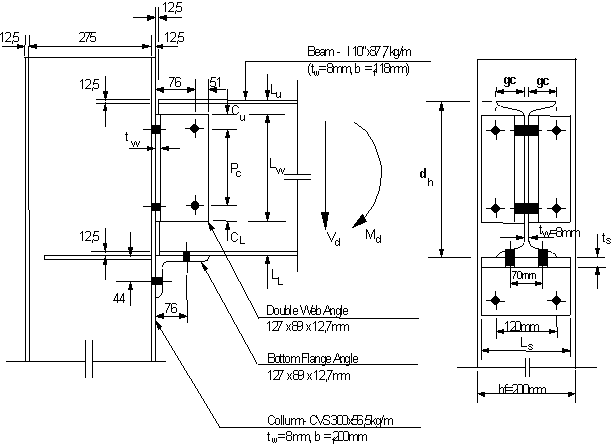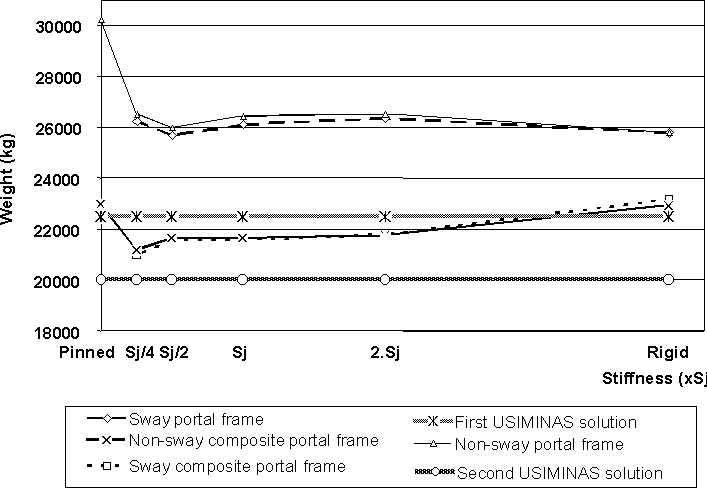
engineering & technology publications
ISSN 1759-3433
PROCEEDINGS OF THE SIXTH INTERNATIONAL CONFERENCE ON COMPUTATIONAL STRUCTURES TECHNOLOGY
A Parametric Study of Steel and Composite Semi-Rigid Portal Frames
+Civil Engineering Department, PUC-RIO, Pontifical Catholic University of Rio de Janeiro, Brazil
*Structural Engineering Department, UERJ, State University of Rio de Janeiro, Brazil
$Mechanical Engineering Department, UERJ, State University of Rio de Janeiro, Brazil
Despite the substantial increase in structural design knowledge, the semi-rigid connection steel design is still facing resistance from structural engineers. This can be explained by the fact that few design standards allows their use and by the lack of detailed information of the advantages of the semi-rigid design philosophy.
This paper presents a parametric analysis performed on low-rise steel buildings taking into account all the steps necessary to a semi-rigid design. The analysis considered parameters like: beam-to-column connection stiffness and strength, structural system (steel or composite) and lateral frame stability.
The parametric analysis is based on the procedures proposed in the Eurocode 3, revised annex J, [5], for semi-rigid connection design. Based on this methodology a simple design model was proposed and implemented with the aid of the finite element program ANSYS, [6]. The model included geometrical and material non- linearities and considered the connections semi-rigid behaviour like the one associated with the connection depicted in Figure 96.1, avoiding the conventional approximations suggested in several current steel design standards. The results of these investigations are presented, discussed and compared to standard designs as means to access the economic potential and efficiency of the semi-rigid solutions. The best structural solution, which leads to the minimum steel consumption, for the investigated construction was a non-sway composite semi-rigid structure, Figure 96.2. The parametric analysis results confirmed the advantage of the use of these connections in low height residential buildings.
- 1
- L.R.O. de Lima, P.C.G. daS Vellasco, S.A.L. de Andrade, L.A.P.S. da Silva, "Experimental and Mechanical Model for Predicting the Behaviour of Minor Axis Beam-to-Column Semi-Rigid Joints", International Journal of Mechanical Sciences, 44(6), 1047-1065, 2002. doi:10.1016/S0020-7403(02)00013-9
- 2
- L.C.V. de Carvalho, S.A.L. de Andrade, P.C.G.S. Vellasco, "Experimental Analysis of Bolted Semi-Rigid Connections", Journal of Constructional Steel Research, 46, 1-3, 1998.
- 3
- L.T.S. Ferreira, S.A.L. de Andrade, P.C.G. da S. Vellasco, "Composite Semi- Rigid Connections for Edge and Corner Columns", Eurosteel, Second European Conference on Steel Structures, Prague, 569-572, 1999.
- 4
- L.A.P.S. Silva , L.R.O. de Lima, , P.C.G.S. Vellasco , S.A.L. de Andrade, "Experimental and Numerical Assessment of Beam-to-Column Joints Under Bending and Axial Force", 1st ICSCS � The First International Conference on Steel & Composite Structures, Pusan, Corea, 715-722, 2001.
- 5
- Eurocode 3, PREN - 1993-1-8: 20, Part 1.8: "Design of Joints, Eurocode 3: Design of Steel Structures", CEN, European Com. for Standardisation, 2000.
- 6
- ANSYS, "Basic Analysis Procedures Guide", 3rd Edition, Release 5.5. September 1998.
purchase the full-text of this paper (price £20)
go to the previous paper
go to the next paper
return to the table of contents
return to the book description
purchase this book (price £125 +P&P)

